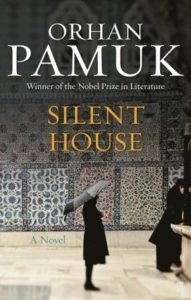Silent House, Orhan Pamuk’s second novel, tells some of the stories of three generations of an extended family. Pamuk rotates among five narrators, each of whom tells their part in the first person. Published in 1983, the book’s main action is set in 1980, just before another military coup shook Turkey.
The house in question is where the family’s matriarch, the grandmother of the other narrators, has lived since she and her husband, the late Dr. Selâhattin Darvinoglu, were exiled from Istanbul by the Committee of Union and Progress (the original “Young Turks”) because of his political views. When Fatma and Selâhattin came to the area, in a time when most Ottoman subjects had no last name (as they did not; Dr. Selâhattin chose one after Atatürk decreed that every Turk should have one), and the surrounding area was nothing but fishing villages. In the intervening decades, the area has become a beach-side playground for people from Istanbul. Many of the plots near their house have been filled with apartment buildings, and indeed some of the younger generation want their grandmother to do the same to prop up the family’s precarious finances.
The first narrator Pamuk introduces is Recep, a dwarf who is the grandmother’s servant. When more of the family comes to visit, he serves them as well, cooking, shopping, cleaning up. Readers soon learn that he is also Selâhattin’s illegitimate child, born to a woman who had served in the household but forced, in Fatma’s younger days, to grow up in a village elsewhere.
Fatma herself is the second narrator. She seldom speaks to the other characters, save for giving orders to Recep, or accusing him of one thing or another. Pamuk allows readers to hear her interior monologue, as she recalls various parts of her life. Married off at age 15 — the process does not seem to have been much more than “he’s a doctor, why not?” — she grows increasingly estranged from him as he embraces science and secularism while she retains the upper-class Ottoman religiosity of her youth. She was a lively and energetic youth, but she’s a mean old lady, and was meaner still in her middle age when she had more physical strength.
The third narrator is named Hasan, and he is the first of three in the grandchildren’s generation. He is the son of Selâhattin’s other illegitimate son, Recep’s brother Ismail, who sells lottery tickets for a living, meaning that he is even poorer than Recep. They live not far from the silent house. Hasan is nearing the end of his schooling, but he can’t be bothered with much of it. He has fallen in with nationalist gangsters, and early on Pamuk shows them shaking down storekeepers, with Hasan desperate to prove himself as tough as others in his little clique.
Faruk is the fourth. He teaches history in Istanbul and has come down to the seaside house with other family members for a traditional summer visit. Faruk also enjoys going to a nearby archive where he does some research into local history, trying to piece together life stories from the traces left in the records. He is heir to his father’s and his grandfather’s predilections: drinking and writing. Selâhattin spent decades trying to write an encyclopedia in the Enlightenment tradition but geared to his countrymen. He believed that there were millions just waiting for him to explain why Turkey had fallen behind the West. He died not long after reaching the letter O, but his manuscript remained unpublished. Faruk is trying to write history, but he is too fond of raki to make much progress.
Faruk’s younger brother Metin is the fifth. Like Hasan, he is nearing the end of his schooling. Unlike Hasan, he is diligent in his studies, and he makes a considerable amount of money tutoring other wealthy high school students. Both Hasan and Metin have big dreams, and are not clear at all about how to attain them. Both are also clueless about and inappropriate around women their own age. More than inappropriate, actually.
I can see the art in what Pamuk is doing; I can admire his technique, especially in just his second book; I can see where approaches that he developed in Silent House flowered in books like The New Life or Snow. But actually reading the book, I struggled not to pronounce the Eight Deadly Words and close its covers. I suppose that’s mostly an illustration that mundane fiction often doesn’t hold my interest, even when it’s written by an author whose later works are undeniably great.

